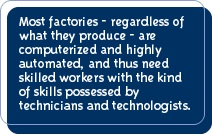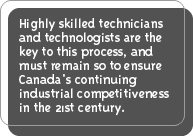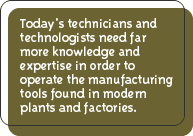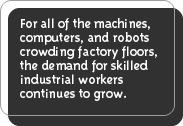|
The
last two hundred years of our history tells the story of industry and
mass production. What started with the introduction of the steam loom
to textile mills in the north of England has become the defining innovation
of our civilization - industrial mass production.
In
the last five or six decades the shop floor has changed dramatically.
From the soot and grime and constant noise of the Industrial Revolution,
we've moved to high-technology, industrial robots, and computer controlled
production lines. Things have become cleaner, safer, and more efficient.
But the lessons of  history
remain the same - regardless of technology, it's the workers who count,
not the machinery. The nature of industrial work has changed, however.
The old distinctions between "high" and "low" technology no longer exist.
Most factories - regardless of what they produce - are computerized
and highly automated, and thus need skilled workers with the kind of
skills possessed by technicians and technologists. history
remain the same - regardless of technology, it's the workers who count,
not the machinery. The nature of industrial work has changed, however.
The old distinctions between "high" and "low" technology no longer exist.
Most factories - regardless of what they produce - are computerized
and highly automated, and thus need skilled workers with the kind of
skills possessed by technicians and technologists.
Although
the human element remains crucial to the process, industrial lathes,
milling machines, and die forges in modern-day plants and factories
turn out mass-produced goods with a speed and precision that would be
unachievable by even the steadiest and most adept human hands.
But
it doesn't stop there. In the 1980s, computer-aided design/computer-aided
manufacturing (CAD/CAM), became standard technologies in manufacturing
industries, computerizing the manufacturing process from conception
to packaging. CAD/CAM's greatest impact has been in the automotive and
aerospace industries where complex virtual models of cars and airplanes
are completely designed by computer and then transformed into the real
thing.
For
example, Bombardier Aerospace's Global Express long-range business jet
didn't exist outside of the memory circuits of a supercomputer until
the first production model rolled off the company's Montreal assembly
line in 1998. The jet's prototype was virtual - it was entirely digitally
designed and tested.
This
plane existed first as a digital prototype, where each part - from the
wingtips to the bolts that hold down the passenger seats - was precisely
designed to near-perfection before any actual building occurred.  That
information was transmitted to Bombardier's computerized plants for
manufacturing and assembly. All of the parts fit together perfectly,
exactly as they were designed. That
information was transmitted to Bombardier's computerized plants for
manufacturing and assembly. All of the parts fit together perfectly,
exactly as they were designed.
Digital
technology has led directly to the exciting new principle of "boutique
production," an area where Canadian industry leads the world. Taking
an industrial design from paper to prototype once took weeks or months
and the labour of a half-dozen skilled craftspeople. Canadian companies
can now take CAD-produced industrial designs and turn out industrial
prototypes, models, and even limited production runs in 24 hours or
less. Highly skilled technicians and technologists are the key to this
process, and must remain so to ensure Canada's continuing industrial
competitiveness in the 21st century.
Nevertheless,
even the work of assembling parts and driving rivets has become mechanized,
computerized, and roboticized. Look down the line of the most modern
high-tech factories today and you'll see rows of robots tirelessly repeating
the most mundane industrial tasks.
None
of this means that the human industrial worker has become obsolete -
in fact, far from it. Industrial technology on the brink of the 21st
century is far more complex than the machines that drove the industrial
revolution in the nineteenth century. Today's technicians and technologists
need far more knowledge and expertise in order to operate the manufacturing
tools found in modern plants and factories.
 Industrial
workers today might be technicians, technologists, computer operators,
or machinists. Instruments have to be calibrated, computer-aided manufacturing
machines need to be programmed and maintained, and the networks carrying
instructions to the tireless robotic production lines must be kept running.
Most importantly, it takes human ingenuity and intelligence to send
those instructions in the first place, and to ensure that they are properly
carried out. Computer-aided manufacturing would be impossible without
human input in management, planning, and quality control. Industrial
workers today might be technicians, technologists, computer operators,
or machinists. Instruments have to be calibrated, computer-aided manufacturing
machines need to be programmed and maintained, and the networks carrying
instructions to the tireless robotic production lines must be kept running.
Most importantly, it takes human ingenuity and intelligence to send
those instructions in the first place, and to ensure that they are properly
carried out. Computer-aided manufacturing would be impossible without
human input in management, planning, and quality control.
The
conventional wisdom once held that Canada was moving from a manufacturing
to a service and information based economy and that consequently, manufacturing
jobs would migrate to warmer and cheaper climes like Mexico and Asia.
The fact is, that hasn't happened.
Between
1992 and 1997, Canadian manufacturing has taken off. Transportation
equipment industries - including the aerospace and automotive industries
- grew 44 percent in that period to account for almost $20 billion
of  Canada's
gross domestic product. Even more dramatic was the machinery industry's
74 percent growth over the same period. Canada's
gross domestic product. Even more dramatic was the machinery industry's
74 percent growth over the same period.
For
all of the machines, computers, and robots crowding factory floors,
the demand for skilled industrial workers continues to grow. Manufacturing
industries recovered well from the economic hard times of the 1980s,
and their employment levels have been on the increase in the past few
years. After two centuries of mass production, industrial and technological
revolutions have transformed factories from dark and sooty mills of
toil to clean and efficient automated assembly lines. And yet, one constant
has remained - it is impossible to separate the skilled worker from
his or her work or production tools.

|